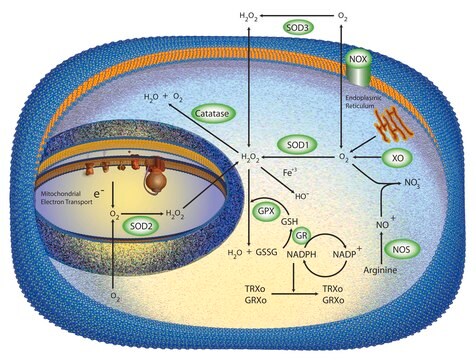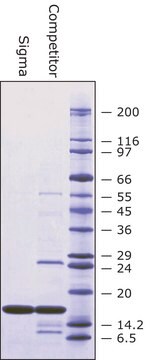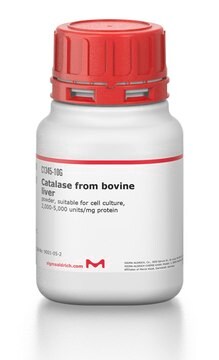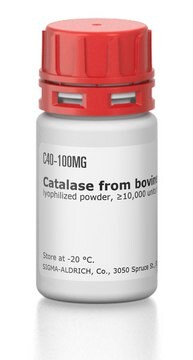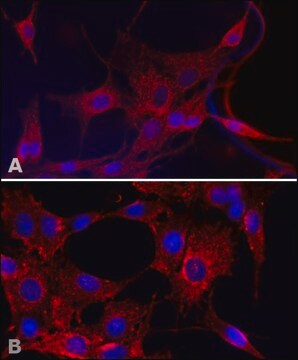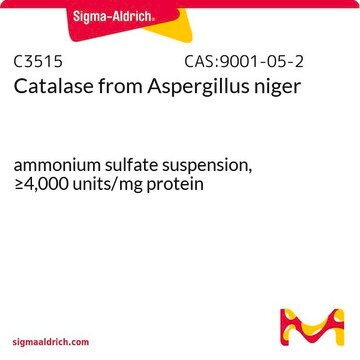S5639
Superoxide Dismutase from Escherichia coli
lyophilized powder, ≥1,000 units/mg protein
Synonym(s):
SOD, Superoxide: superoxide oxidoreductase
Sign Into View Organizational & Contract Pricing
All Photos(1)
About This Item
Recommended Products
form
lyophilized powder
Quality Level
specific activity
≥1,000 units/mg protein
mol wt
39.5 kDa
composition
Protein, ≥70% biuret
storage temp.
−20°C
Gene Information
Escherichia coli CFT073 ... sodA(1040208) , sodB(1036179) , sodC(1036143)
Looking for similar products? Visit Product Comparison Guide
General description
Superoxide dismutases are a group of low molecular weight metalloproteins present in all aerobic cells of plants, animals and micro-organisms. They provide protection against damaging reactions with the superoxide radical anion (O2-) by catalyzing its disproportionation into oxygen and hydrogen peroxide. The direct electron transfer of superoxide dismutases can be efficiently promoted by a self-assembled monolayer of 3-mercaptopropionic acid confined on a gold electrode.
Application
Superoxide dismutase from Escherichia coli has been used in a study to determine that anion binding properties of reduced and oxidized iron-containing superoxide dismutase reveal no requirement for tyrosine 34. Superoxide dismutase from Escherichia coli has also been used in a study to demonstrate that molecular dynamics simulation and limited proteolysis are complementary and specific tools to identify flexible sites in proteins.
Biochem/physiol Actions
Catalyzes the dismutation of superoxide radicals to hydrogen peroxide and molecular oxygen. Plays a critical role in the defense of cells against the toxic effects of oxygen radicals. Competes with nitric oxide (NO) for superoxide anion (which reacts with NO to form peroxynitrite), thereby SOD promotes the activity of NO. SOD has also been shown to suppress apoptosis in cultured rat ovarian follicles, neural cell lines, and transgenic mice.
Other Notes
Manganese-containing enzyme
Unit Definition
One unit will inhibit reduction of cytochrome c by 50% in a coupled system with xanthine oxidase at pH 7.8 at 25 °C in a 3.0 mL reaction volume. Xanthine oxidase concentration should produce an initial ΔA550 of 0.025 ± 0.005 per min.
Physical form
Contains Tris buffer salts
Analysis Note
For assay method, see McCord, J.M. and Fridovich, I., J. Biol. Chem., 244, 6049 (1969).
Signal Word
Danger
Hazard Statements
Precautionary Statements
Hazard Classifications
Resp. Sens. 1
Storage Class Code
10 - Combustible liquids
WGK
WGK 1
Flash Point(F)
Not applicable
Flash Point(C)
Not applicable
Personal Protective Equipment
dust mask type N95 (US), Eyeshields, Gloves
Choose from one of the most recent versions:
Already Own This Product?
Find documentation for the products that you have recently purchased in the Document Library.
Customers Also Viewed
Yang Tian et al.
Analytical chemistry, 76(14), 4162-4168 (2004-07-16)
In this article, the electrochemical properties and electrocatalytic activity of three kinds of superoxide dismutases (SODs), that is, bovine erythrocyte copper-zinc superoxide dismutase (Cu/Zn-SOD), iron superoxide dismutase from Escherichia coli (Fe-SOD), and manganese superoxide dismutase from E. coli (Mn-SOD), in
M Falconi et al.
Proteins, 47(4), 513-520 (2002-05-10)
Limited proteolysis by trypsin of monomeric Cu,Zn superoxide dismutase from Escherichia coli induces a specific cleavage of the polypeptide chain at the level of Lys60 located in the S-S subloop of loop 6,5 where, when compared to the eukaryotic enzyme
Anne-Frances Miller et al.
Biochemistry, 44(16), 5969-5981 (2005-04-20)
We report the first spectroscopic observation of substrate analogue binding to the reduced state of iron superoxide dismutase from Escherichia coli (Fe(2+)SOD) and demonstrate that the pH dependence reflects inhibition of anion binding by ionized Tyr34, not loss of a
David G Westbrook et al.
Cardiovascular toxicology, 10(3), 216-226 (2010-07-30)
Epidemiological studies suggest that events occurring during fetal and early childhood development influence disease susceptibility. Similarly, molecular studies in mice have shown that in utero exposure to cardiovascular disease (CVD) risk factors such as environmental tobacco smoke (ETS) increased adult
Vera G Grivennikova et al.
Redox biology, 17, 192-199 (2018-04-28)
The initial rates of superoxide plus hydrogen peroxide (ROS) generation by intact or permeabilized rat heart mitochondria and coupled inside-out bovine heart submitochondrial particles (SMP) oxidizing NAD-dependent substrates, NADH, and succinate were measured by detecting resorufin formation in the Amplex
Protocols
Enzymatic Assay of Superoxide Dismutase
Separation of Superoxide dismutase
Chromatograms
application for HPLCOur team of scientists has experience in all areas of research including Life Science, Material Science, Chemical Synthesis, Chromatography, Analytical and many others.
Contact Technical Service